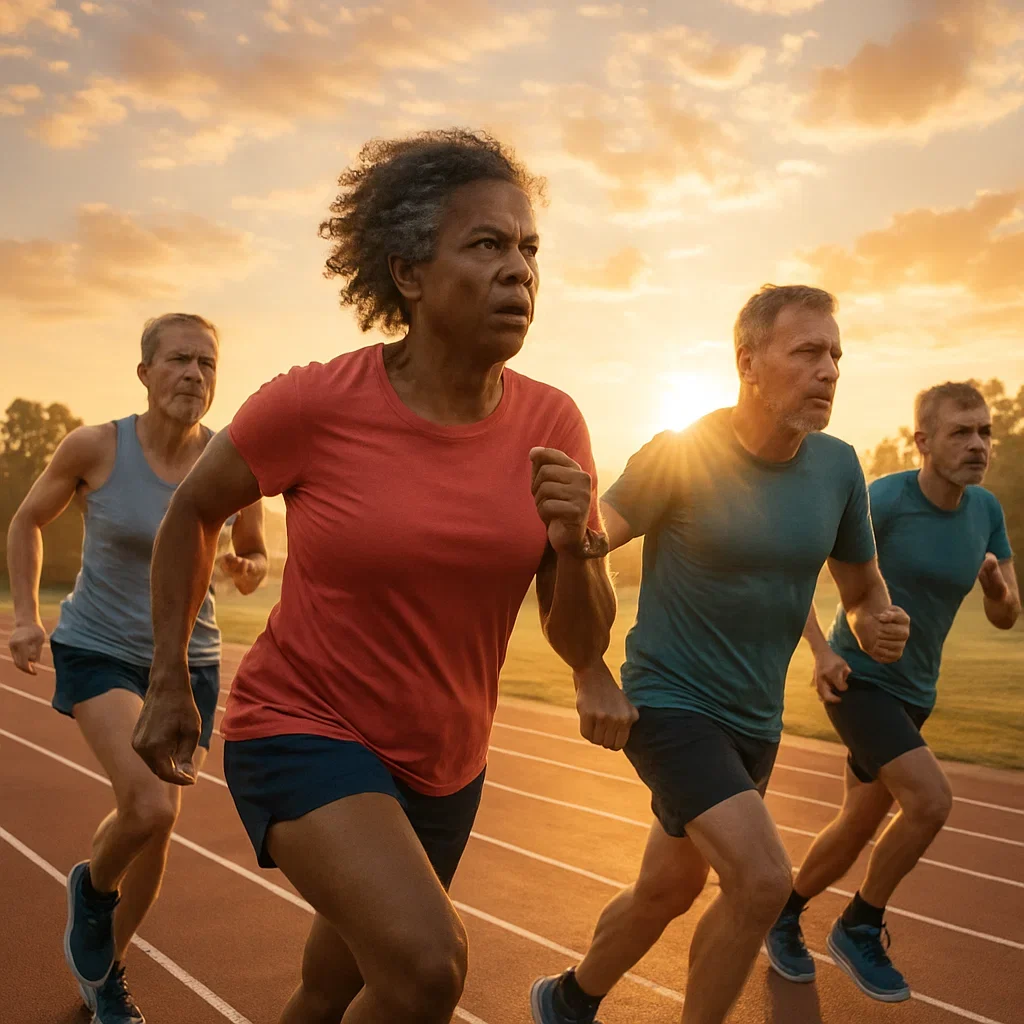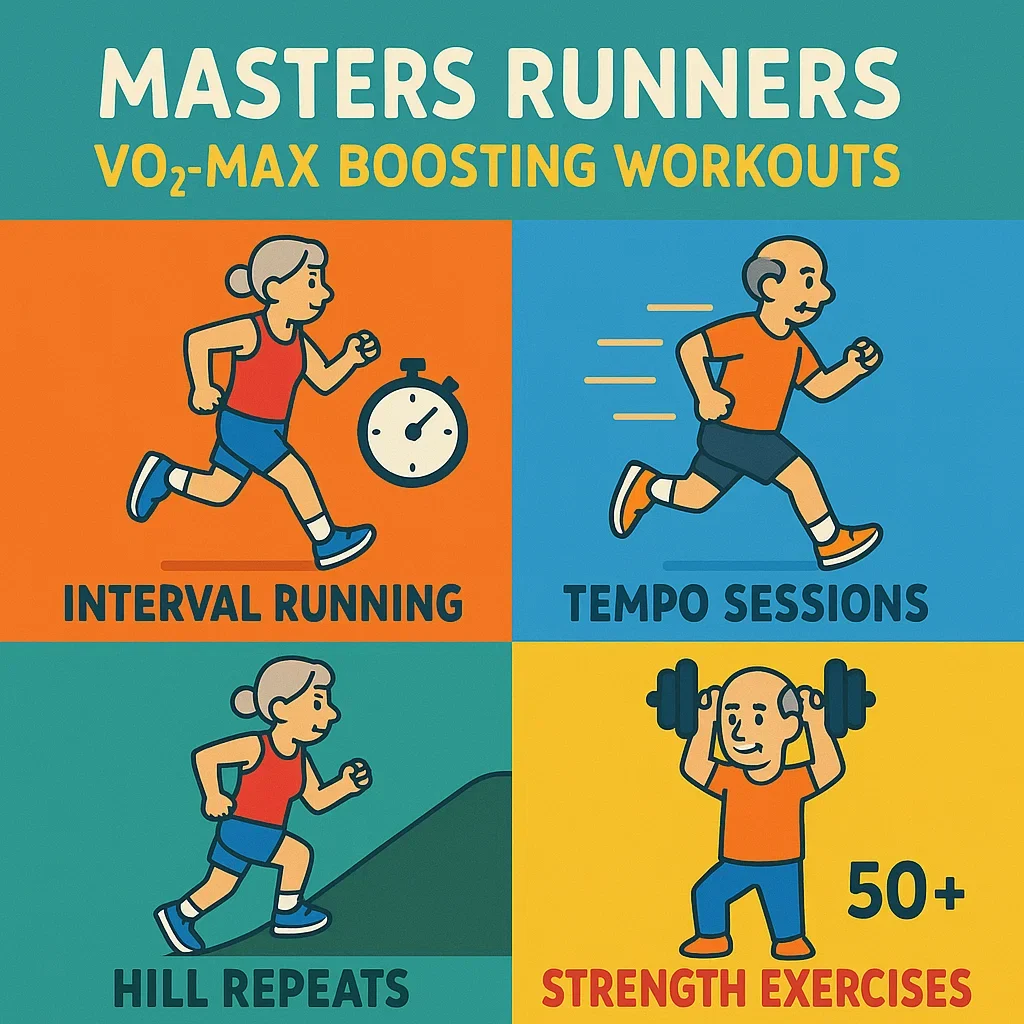VO2-Max Decline: Why It Happens—and Why It’s Not Inevitable
If you’re over 40, you’ve probably heard it: “VO2-max drops with age, no matter what.” But new research shows masters runners can slow—or even reverse—much of that decline with the right training and habits. You are not doomed to fade! This guide covers the workouts, nutrition, and lifestyle tweaks that keep your heart, lungs, and muscles thriving well into your 50s, 60s, and beyond.
- 📉 What is VO2-max? Your body’s max oxygen use during hard effort—a key marker for endurance.
- 🧬 Why does it decline? Lower max heart rate, muscle loss, hormonal shifts, less intense training… but these can be countered!
- 💪 Why does it matter? VO2-max predicts not just race performance, but healthy aging and independence.
Science-Backed Workouts to Maintain (and Boost) VO2-Max After 40
- Interval Training: Short bursts (2–5 min) at 90–100% of max effort, with equal or slightly longer recovery. Example: 5 × 3 minutes fast, 3 minutes easy jog between.
- Tempo Sessions: 20–40 minutes at a “comfortably hard” pace (about 85–90% max heart rate). Great for lactate threshold and heart adaptation.
- Hill Repeats: Uphill running activates fast-twitch fibers and boosts aerobic power. Try 6–10 × 1–2 minutes up a moderate hill, with walk/jog down.
- Strength Training: Twice weekly sessions targeting legs, hips, and core preserves muscle mass and oxygen delivery. Don’t skip: squats, lunges, deadlifts, calf raises.
Studies (2020–2024) confirm masters who consistently do interval and strength training preserve up to 85–90% of their “young adult” VO2-max, while those who stop hard efforts lose fitness far faster.
Consistency beats intensity—keep showing up!
Nutrition & Supplement Strategies for VO2-Max Longevity
- Protein Intake: 1.2–1.7g/kg/day slows muscle loss and supports repair, especially for plant-based athletes.
- Iron & B12: Both are crucial for red blood cell function and oxygen transport—get levels checked annually, especially for vegans and women.
- Omega-3s: Reduce inflammation and may improve cardiac efficiency; consider algae or fish oil supplements if intake is low.
- Creatine: Not just for sprinters—shown to aid muscle mass retention and training intensity in older adults.
- Vitamin D & Antioxidants: Important for immune health and muscle function, particularly in winter or limited sun exposure.
Recovery supplements masters and nutrient-dense meals (think: lentils, leafy greens, nuts, seeds, tofu, berries) support every training adaptation. Hydrate well, especially during high-intensity days!
Lifestyle Hacks & Non-Exercise Methods to Boost VO2-Max
- Altitude Exposure: Periodic training or travel at moderate altitude (1–3 weeks/year) can increase red blood cells and VO2-max. (Even sleeping in a hypoxic tent helps some athletes!)
- Sleep & Recovery: Aim for 7–9 hours/night and schedule at least one full rest day weekly. Good sleep supports hormonal balance and muscle repair.
- Breath Training: Diaphragm strengthening and slow, controlled breathing drills improve oxygen efficiency.
- Cross-Training: Cycling, swimming, or hiking work the heart and lungs in different ways—helpful if injury risk limits run volume.
- Stress Management: Chronic stress hinders aerobic adaptation. Mindfulness, yoga, and time in nature keep your system resilient.
Putting It All Together: Take Charge of Your VO2-Max After 40
Preventing VO2-max decline isn’t about miracles—just smart, steady effort.
Add a weekly interval, lift weights, eat for recovery, prioritize rest, and never stop learning.
Every runner loses a little VO2-max with age. But with consistency, curiosity, and passion, your “engine” can stay strong for decades.
Longevity is the ultimate ultramarathon.
❓ Frequently Asked Questions: VO2-Max for Masters Runners
🟢 Can VO2-max really improve after age 50?
🟢 How often should I include VO2-max intervals?
🟢 Which supplement is best for oxygen delivery?
🟢 Does altitude training really work?
🟢 What if I can’t run due to injury?
🟢 Is “more” always better for VO2-max?
🟢 How do I track my VO2-max at home?
📚 Further Reading & Resources
🔗 Share This Article
Know a runner who needs inspiration? Share this science-based VO2-max guide!
💬 Join the Conversation!
What’s your top tip for maintaining fitness after 40? Have you noticed a change in your VO2-max? Share your experiences, questions, or personal breakthroughs below—or join the discussion on our community page!
🚀 Lost Pace Motivation
Age is just another variable—your determination, habits, and passion matter far more. Keep challenging your limits and enjoy every run. Your best chapters may still be ahead!


About the Author
Lost Pace is an ultramarathon runner, shoe-tester and the founder of umit.net. Based year-round in Türkiye’s rugged Kaçkar Mountains, he has logged 10,000 + km of technical trail running and completed multiple 50 K–100 K ultras.
Blending mountain grit with data, Lost analyses power (CP 300 W), HRV and nutrition to craft evidence-backed training plans. He has co-written 260 + long-form guides on footwear science, recovery and endurance nutrition, and is a regular beta-tester of AI-driven coaching tools.
When he isn’t chasing PRs or testing midsoles, you’ll find him sharing peer-reviewed research in plain English to help runners train smarter, stay healthier and finish stronger.
Ultrarunner · Data geek · Vegan athlete

